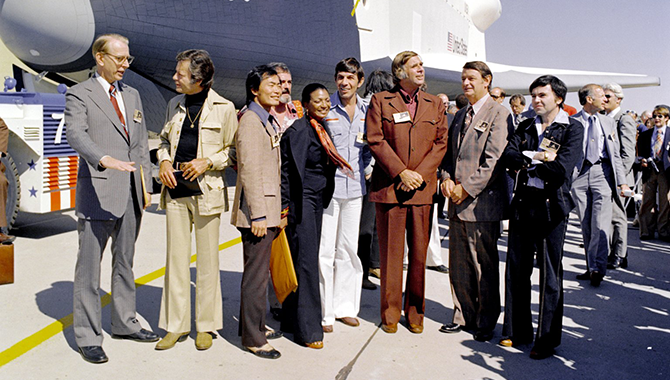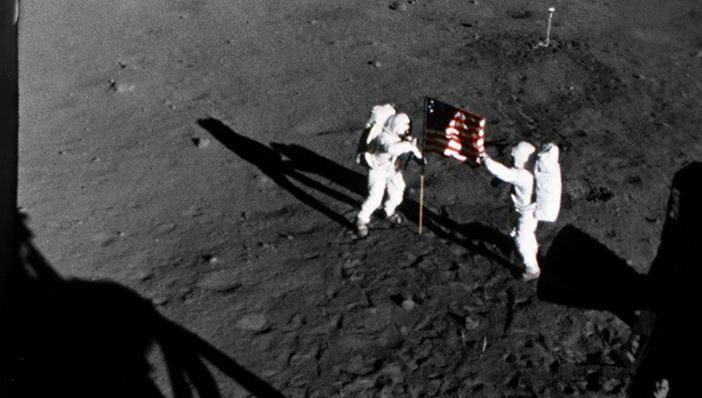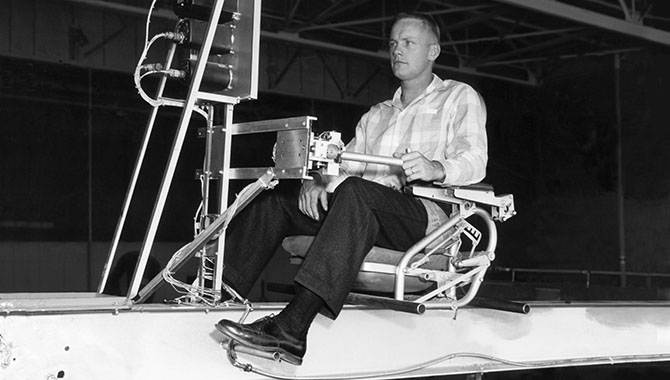
Members of the cast and creator of the popular TV show Star Trek attending the rollout of the space shuttle prototype Enterprise at Air Force Plant 42 in Palmdale in 1976. From left, NASA administrator James Fletcher, DeForest Kelly, George Takei, Nichelle Nichols, Leonard Nimoy, Gene Rodenberry and Walter Koenig.
Photo Credit: NASA
The original Star Trek episode “Spock’s Brain” is not as well-ranked or well-starred as the fuzzball populated “Trouble with Tribbles.”
The story is not as masterfully written as “Amok Time” (by Theodore Sturgeon) or “The City on the Edge of Tomorrow” (by Harlan Ellison), but for those working in knowledge services, the plot has a certain attraction.
After encountering a spaceship with technology that leaves Chief Engineer Scotty giddy, the Enterprise is boarded by a humanoid woman dressed like a go-go dancer from 1968 (or “stardate 5431.4”). By pressing a gemlike stud on her Wonder Womanesque bracelet, she makes the crew of the Enterprise pass out. Upon awakening, the crew discovers Science Officer Spock’s brain has been surgically, wholly removed. His body has exactly 24-hours to live without said “mind”—as stated by Medical Officer McCoy—and, thus, Captain Kirk is off to find the go-go dancer to whom Spock has lost his mind.
Much of the rest of the storyline occurs on a glacial M-class planet where, miraculously, everyone speaks American English. The narrative is a field day for anyone interested in gender studies, particularly 1960s sexism. It is also camp, as in “startlingly exaggerated” (as most Star Trek episodes tend to be) and not as in flashlights and smores, though Checkov does make a “fire” by phasering a half-buried boulder until it glows hotly.
The conflict of “Spock’s Brain” comes, as it often does in sci-fi, from what might seem as a circular question: how would human behavior change if some new technology came along that could really change it? On this icy M-class, there exists a machine—a 1960s beauty salon’s hair-drying helmet—that can transfer knowledge. And this device—called “the teacher”—can transfer knowledge (how-to and what-of) to those who stick their big noggins into it.
Instead of a utopia, the teacher has made, Kirk muses, life on the frozen planet polarized. The sexes can’t relate, and who better than Kirk to point this out to our go-go model while he holds her bare arms in his sympathetic hands. The teacher not only polarizes knowledge between the sexes, the teacher singularizes knowledge, as in only-brain-knows-all. Spock’s brain is doing all the work for everyone on the planet. The men are monosyllabically brutes, and the women are dutiful children when not stealing brains.
Still, for all the drawbacks of this knowledge-transfer teacher, we are almost tempted to want one. NASA could place the dispersing workforce—changing jobs or leaving details or retiring altogether—into this dome and capture much knowledge for easy transfer to someone else. The problem with the teacher is its application on this frozen planet: it is not employed democratically, and it not applied with clarifying moral context. In short, the teacher is abusing and abused.
By becoming familiar with the different types of knowledge, all NASA can begin to build a culture of knowledge sharing. Those philosophizing about how we think have never ignored the relationship between and having words and thoughts. To do knowledge management, we need to share a vocabulary to accelerate sharing what we know.
Although the dialogue from “Spock’s Brain” does not use these terms, the concepts are built into the episode’s mission, solving the mystery of Spock’s missing brain, as sure as NASA is on a mission to be successful capturing and sharing knowledge.
The NASA Knowledge Policy defines its terms:
Knowledge: In individuals: rich, complex, and organized pattern recognition and understanding. In organizations: the collective capability and capacity to perform an operation.
Explicit Knowledge: Knowledge that has been articulated, codified, and stored, most often in procedures, manuals, videos, data, documents, and images.
Knowledge Transfer: To transfer a body of explicit knowledge, artifacts, or know how from one entity to another, enabling the recipient to actively use the newly acquired knowledge.
Tacit Knowledge: Knowledge that is embodied in an individual, making it difficult or impossible to express explicitly.
Knowledge Gaps: Gaps in knowledge as a result of retirements, workforce demographic trends, program closeouts, the introduction of new environment issues, or unanticipated knowledge needs.
Knowledge Management: A collection of policies, processes, and practices relating to the use of intellectual and knowledge based assets in an organization.
And here is the plot-spoiler: the teacher transfers to McCoy the knowledge of how to re-insert Spock’s brain. There is, of course, a twist to the scene of re-insertion: the knowledge only “stays” in McCoy’s brain for a few hours (and cannot be re-booted because McCoy is only a mere human), so Spock (with mouth already connected to brain by McCoy) has to talk McCoy through the rest of the operation to put back all of his brain.
To the serious trekker or trekkie, one must note that Spock’s Vulcan mind-meld does what the teacher does in “Spock’s Brain”—serious fans must assume only to a lesser magnitude. A little suspension of disbelief goes a long way in enjoying this classic TV show, the launch of the franchise. The Star Trek Universe is complex and varied: it is loved not for always getting its plot points perfect but for its human endeavor of boldly going where no one has gone before.
Leonard Nimoy—poet, photographer, actor, director, and humanitarian—has lived long and prospered. On his death at age 83, it might seem like the universe is a smaller place. Phrasing his passing with this “smaller universe” idea might be, especially to Mr. Spock, highly illogical. Nimoy, however, was more the poet. Both may understand that to fans of the fictional character and the real person, the universe might seem less “fascinating” in the best sense of the word. We can find comfort in knowing, like any Science Officer, that energy is never really lost. Energy is transfers into other forms. May memories of Spock and Nimoy energize you to share your knowledge and may you live long and prosper.









